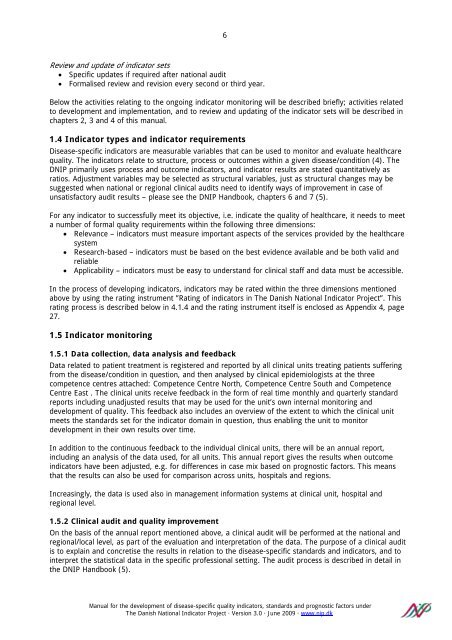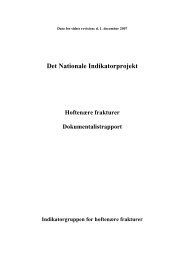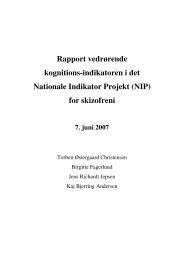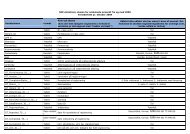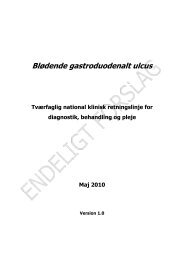The Danish National Indicator Project - NIP
The Danish National Indicator Project - NIP
The Danish National Indicator Project - NIP
You also want an ePaper? Increase the reach of your titles
YUMPU automatically turns print PDFs into web optimized ePapers that Google loves.
Review and update of indicator sets<br />
• Specific updates if required after national audit<br />
• Formalised review and revision every second or third year.<br />
6<br />
Below the activities relating to the ongoing indicator monitoring will be described briefly; activities related<br />
to development and implementation, and to review and updating of the indicator sets will be described in<br />
chapters 2, 3 and 4 of this manual.<br />
1.4 <strong>Indicator</strong> types and indicator requirements<br />
Disease-specific indicators are measurable variables that can be used to monitor and evaluate healthcare<br />
quality. <strong>The</strong> indicators relate to structure, process or outcomes within a given disease/condition (4). <strong>The</strong><br />
D<strong>NIP</strong> primarily uses process and outcome indicators, and indicator results are stated quantitatively as<br />
ratios. Adjustment variables may be selected as structural variables, just as structural changes may be<br />
suggested when national or regional clinical audits need to identify ways of improvement in case of<br />
unsatisfactory audit results – please see the D<strong>NIP</strong> Handbook, chapters 6 and 7 (5).<br />
For any indicator to successfully meet its objective, i.e. indicate the quality of healthcare, it needs to meet<br />
a number of formal quality requirements within the following three dimensions:<br />
• Relevance – indicators must measure important aspects of the services provided by the healthcare<br />
system<br />
• Research-based – indicators must be based on the best evidence available and be both valid and<br />
reliable<br />
• Applicability – indicators must be easy to understand for clinical staff and data must be accessible.<br />
In the process of developing indicators, indicators may be rated within the three dimensions mentioned<br />
above by using the rating instrument ”Rating of indicators in <strong>The</strong> <strong>Danish</strong> <strong>National</strong> <strong>Indicator</strong> <strong>Project</strong>”. This<br />
rating process is described below in 4.1.4 and the rating instrument itself is enclosed as Appendix 4, page<br />
27.<br />
1.5 <strong>Indicator</strong> monitoring<br />
1.5.1 Data collection, data analysis and feedback<br />
Data related to patient treatment is registered and reported by all clinical units treating patients suffering<br />
from the disease/condition in question, and then analysed by clinical epidemiologists at the three<br />
competence centres attached: Competence Centre North, Competence Centre South and Competence<br />
Centre East . <strong>The</strong> clinical units receive feedback in the form of real time monthly and quarterly standard<br />
reports including unadjusted results that may be used for the unit’s own internal monitoring and<br />
development of quality. This feedback also includes an overview of the extent to which the clinical unit<br />
meets the standards set for the indicator domain in question, thus enabling the unit to monitor<br />
development in their own results over time.<br />
In addition to the continuous feedback to the individual clinical units, there will be an annual report,<br />
including an analysis of the data used, for all units. This annual report gives the results when outcome<br />
indicators have been adjusted, e.g. for differences in case mix based on prognostic factors. This means<br />
that the results can also be used for comparison across units, hospitals and regions.<br />
Increasingly, the data is used also in management information systems at clinical unit, hospital and<br />
regional level.<br />
1.5.2 Clinical audit and quality improvement<br />
On the basis of the annual report mentioned above, a clinical audit will be performed at the national and<br />
regional/local level, as part of the evaluation and interpretation of the data. <strong>The</strong> purpose of a clinical audit<br />
is to explain and concretise the results in relation to the disease-specific standards and indicators, and to<br />
interpret the statistical data in the specific professional setting. <strong>The</strong> audit process is described in detail in<br />
the D<strong>NIP</strong> Handbook (5).<br />
Manual for the development of disease-specific quality indicators, standards and prognostic factors under<br />
<strong>The</strong> <strong>Danish</strong> <strong>National</strong> <strong>Indicator</strong> <strong>Project</strong> · Version 3.0 · June 2009 · www.nip.dk


